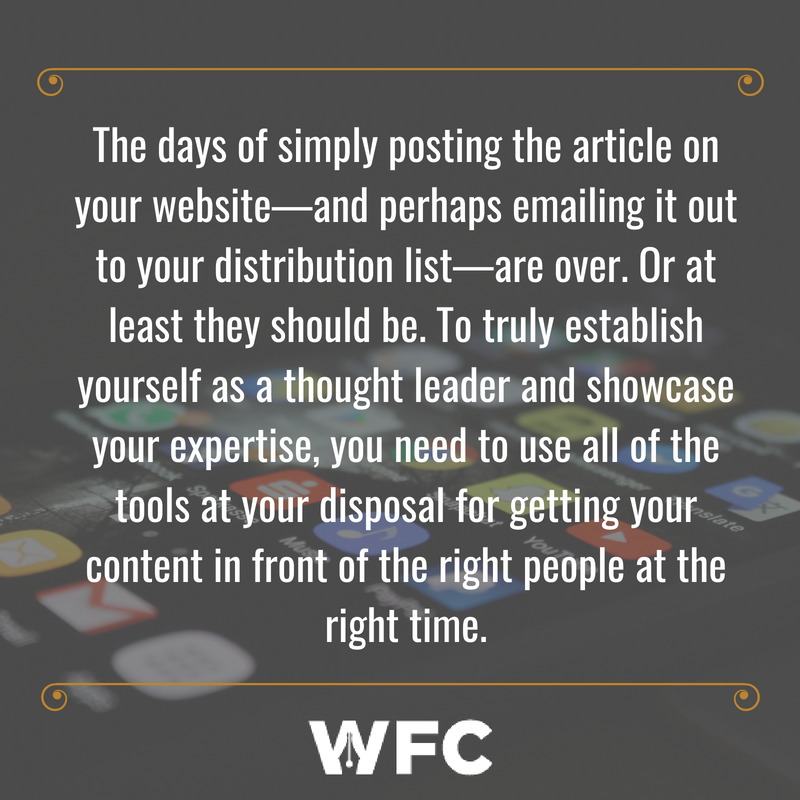Believe it or not, social media isn’t just for posting funny cat memes or pictures of the perfectly prepared apple pancake you ate at brunch over the weekend. Social media is actually a powerful tool for establishing yourself as a thought leader in the financial services industry.
Whether you’re personally a social media enthusiast or not, there’s no denying the power of these platforms for connecting with your target audience and sharing articles that align with your area of expertise. This is especially true when it’s an article, blog post, or white paper that you wrote.
The days of simply posting the article on your website—and perhaps emailing it out to your distribution list—are over. Or at least they should be. To truly establish yourself as a thought leader and showcase your expertise, you need to use all of the tools at your disposal for getting your content in front of the right people at the right time. And social media is undoubtedly one of the most powerful tools.
But like any tool, you need to know how to use it, or you could cause some damage. Here are four things financial marketers should keep in mind when trying to promote their thought-leadership content over the various social media platforms.
Context Matters: Don’t Just Copy and Paste Headlines
Many social media “newbies” might find it easy and efficient to simply copy and paste a link to their blog into Twitter along with the post’s headline and press send. And they might use the same across all of their social media platforms—Twitter, Facebook, or LinkedIn.
The problem is, this approach ignores the context of these social media platforms. And when that context is ignored, your tweet or post falls flat with the audience. In other words, it’s tone deaf.
Imagine walking into a networking cocktail event and, without hesitation upon entering, throwing your jacket off and yelling, “My name is Frank Kalman, and I’m the chief operations officer at Wentworth Financial Communications.” (I’ve never done this, for the record.) You attended the networking event to get your name and business out there, but going about it this way is probably going to get you more weird looks than business cards.
Each social media channel has a context and norms that people use to communicate and share content; make sure that when you post or share your content over those mediums that you’re following those rules.
For example, don’t assume that a sentence used in your white paper will automatically work well in your Twitter post about the white paper. White papers are very formal pieces of thought-leadership content; Twitter is very informal and conversational. Therefore, make sure that when you write a post for Twitter to share your white paper you take on a more informal, conversational tone. Also, realize that while a very conversational tone is appropriate on Twitter, LinkedIn probably calls for a more buttoned-down approach given its B2B focus, whereas Facebook is a good venue for making more emotional, personal connections.
Visuals Matter; Use Lots of Them
“A picture can be worth a thousand words.” When it comes to social media, this old axiom is truer than ever.
The more visuals that you can use in your social media post, the better. People are more likely to quickly scan social media posts—some statistics say people form an immediate impression of your post within 50 milliseconds—so you better grab their attention quickly and make your post stand out in the user’s feed. And there’s no better way to do this than with a nicely designed visual—either a picture or graphic—that includes some sort of interesting or important nugget from whatever piece of content you’re promoting.

But before posting whatever beautiful chart, photo, or infographic you created for your social media post, make sure that it’s sized appropriately for the platform. Sometimes simply posting a screenshot or pulling directly from a visual used in a white paper or blog won’t translate clearly to social media.
Realize Social Media is (Mostly) a Two-Way Street
Remember, social media is intended to be a two-way communication channel, not just a one-way street for you to broadcast your content. This is something that many marketers preach but fail to practice. (And we’re guilty of this at Wentworth Financial Communications.)
Facebook, LinkedIn, Instagram, Twitter, YouTube, and any other social media channel, are great at allowing anyone to broadcast their brand and thought leadership. But what makes these platforms compound in value is when the same people using them as a broadcast medium actually take the time to engage and interact with the people who are commenting and responding to the content they’re posting.
For instance, when you create a post on LinkedIn promoting your most recent blog, make sure that you’re using the post to ignite a conversation about an important topic in your industry or field of expertise. Use the post as an opportunity not just to answer common questions for your desired audience but to ask more questions that spur conversation. Then, when your audience inevitably comments or adds to the conversation within your post, don’t just sit idly and observe; take the time to respond and continue fueling the conversation.
That second layer of social media engagement will pay huge dividends, as your audience will form more of a connection with your brand and hopefully tell more people about how cool it was that you actually talked to them on social media.
Financial Marketers Beware: Not Everything Should be Said on Social
This last point is especially true for financial marketers or any other professional that works in a highly regulated industry. Remember: Just because you wrote or said something in a white paper, blog, or video on your company’s website, doesn’t necessarily mean it can—or should—be posted on social media.
That’s because, as a financial services firm, when you post content on your website, it’s usually accompanied by lengthy compliance and disclosure language at the bottom of the page. Content on social media isn’t featuring the same disclosure language.
That’s why it’s so important to understand and follow your firm’s compliance protocol for social media. And if you don’t have one, you need to establish one before you start posting.
That said, happy posting. I hope to see your creative, visual, and—just sometimes—cat-meme-type content on social media sometime soon.
About the Author

Frank Kalman is the chief operations officer at Wentworth Financial Communications. Frank and the team of writers and editors at WFC help professionals across the financial services industry build their brands by creating investment-grade white papers, bylined articles, newsletters, blogs, social media posts, and other forms of content marketing.
